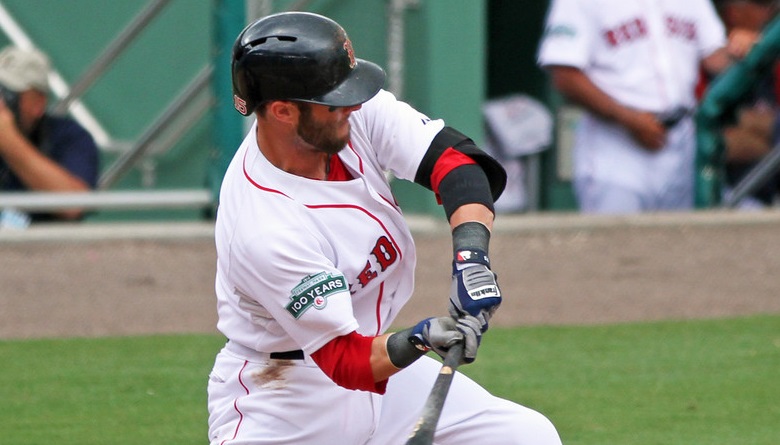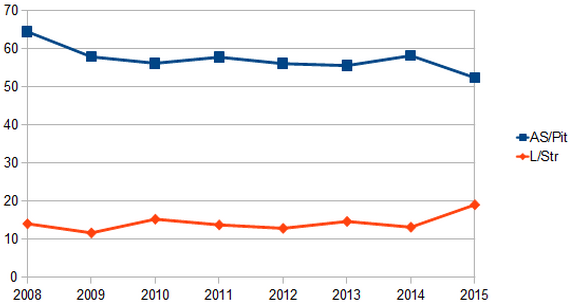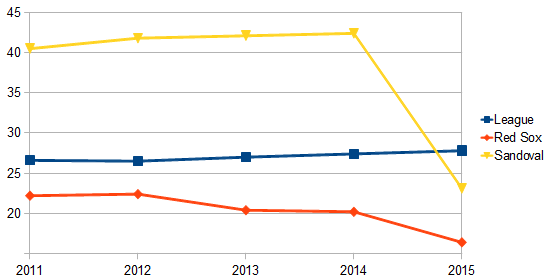In The Science of Hitting, Ted Williams pointed out “Three Rules to Hit By” that have stayed on the stone tablets of the sport. The third is simple: be quick with the bat. The second is more complicated, and is probably where the most advances have been made recently: proper thinking, doing homework, learning pitcher tendencies. But the first — get a good ball to hit — is as important as it’s always been.
It makes sense. From Joe Kerrigan to John Farrell, we’ve heard again and again about the importance of a first strike for pitchers. Since Farrell’s return, we’ve seen Red Sox hitters take more of a command of the count. It helps to have good hitters, and the team has had plenty of those. But it could be a more deliberate strategy.
It’s hard for a team to consistently dominate plate discipline statistics year after year, but the Red Sox have recently done a pretty good job of that. At Baseball-Reference, AS/Pit measures the percentage of non-intentional-ball pitches at which a batter swung (“swing percentage”). L/Str is the percentage of strikes that are called looking, also from B-R. Together with Baseball Prospectus’s True Average, all ranks are in descending order:
| Year | AS/Pit | Swing% Rank | L/Str | L/Str Rank | TAv | TAv Rank |
| 2011 | 44.7% | 23th | 28.8% | 8th | .277 | 1st |
| 2012 | 45.4% | 20th | 29.3% | 6th | .259 | 15th |
| 2013 | 43.4% | 30th | 31.2% | 1st | .287 | 1st |
| 2014 | 43.7% | 30th | 31.7% | 1st | .254 | 25th |
| 2015 | 40.5% | 30th | 33.7% | 2nd | .271 | 9th |
The team’s pinball standings match its overall hitting success, as the True Average numbers and rank show. Its recent swing percentage marks have gone from good to elite. The team has been very selective for a long time, frequently ranking among the league leaders from 2003 to 2012. It seems, though, that the Red Sox re-committed to that approach in 2013, as leading the field for three years running is hard to do by accident.
L/Str helps make this look like it’s on purpose. The Red Sox had a commanding lead in that stat in 2013, and in 2014, the Red Sox had a L/Str rate almost two percentage points higher than the second-place Twins — whose 29.9 L/Str was closer to the fourteenth-place Mariners than to Boston’s 31.7%. Taking pitches has been some kind of agenda. And while some hitters added in the last few years have fit that model (Mike Napoli), some haven’t, at least not really (Hanley Ramirez). In fact, the addition of another player this offseason seems like proof all on its own that a low swing percentage is not a requirement for a Red Sox contract.
It’s hard for a team to consistently dominate plate discipline statistics year after year, but the Red Sox have recently done a pretty good job of that.
Pablo Sandoval has been the poster child for hacking, unless you count Chris Hemsworth. In 2014, Sandoval had the highest swing percentage among all 146 qualified hitters. He hacked by land, by air, by sea — he was first swinging on pitches outside the zone and second in the zone. It’s not just that Sandoval isn’t a guy you’d select for his selectivity; it’s that if you’re valuing selectivity on a team-wide basis, bringing him into the fold would be totally incompatible with that approach.
So why would a team with a swing percentage so low that it almost can’t be by accident take on plate discipline anti-matter like Sandoval?
Maybe it’s because they think they can change him. In our meager 2015 sample (through Sunday), Sandoval’s AS/Pit has dropped six percentage points, and is five points below his career swing rate. He’s also taking more strikes so far this year, an almost equal jump of six points from 13.1% last year to 19.0% this year. For what it’s worth, Sandoval has seen 3.53 Pitches Per Plate Appearance for his career, but currently stands at 4.08 for this season.
Maybe this is just noise; most of the Red Sox lineup has been especially selective in the early going. But this fits a trend, especially from the last few seasons. If lowering one’s swing percentage results in better pitches to hit, could a team like the Red Sox make its hitters better just through coaching that philosophy? If so, it wouldn’t really matter how selective the hitters it targets actually are — just whether they become more selective.
If a team were coaching its hitters to be more selective (at least for part of counts), and if it were reaping some kind of reward from that — we’d have some trouble isolating that reward. Swing percentage and the percentage of strikes looking might indicate that it’s happening. What we think might be the desired result, however — better hitting — would be baked right into the statistics we use to evaluate hitters.
One thing we might see would be teams we think of as “smart” matching the Red Sox step for step. Since 2013, the Red Sox lead the field in swing percentage by a fair margin. Second place? Athletics. Third place? Rays. And this may not just be a happy byproduct of OBP, as the Athletics rank seventh in OBP for that period, and the Rays eighth. OBP used to be fairly cheap if you knew where to look. Now, OBP is expensive (just ask Shin-Soo Choo). What if low swing percentage is cheap? What if it’s all the cheaper if it’s something that can be more easily coached? Josh Donaldson had an above-average swing percentage in 2012 (49.0%), but saw his TAv skyrocket from .257 that season to .326 one year later with a percentage down to 44.3%. If it were that easy, the Athletics would have a lineup of Josh Donaldsons. Maybe it’s not easy; maybe it’s that some players can be more easily coached this way.
Coaching players to be more selective is nothing new. But the Red Sox aren’t just more selective; they’re much more selective on first pitches, and that’s where this all starts to make sense. Baseball-Reference tracks a “1stS” statistic, for First Pitch Swinging Percentage. Watch how that tracks for the Red Sox, for league average, and for our hero, Pablo Sandoval:
That drop in swing percentage that we observed before shows up here in 1stS, and once again, the Red Sox aren’t just first in 2013-2015, but first by a significant margin. Not a coincidence. Since one in about 3.8 pitches come in a 0-0 count, the drop of about two percentage points in 1stS between 2011-2012 and 2013-2014 accounts for the vast majority of the drop in swing percentage overall. 1stS will take longer to stabilize than swing percentage overall (small sample alert), but even in just 52 PA, this drop for Sandoval means that he’s swung at the first pitch about 9 times fewer than we would have expected. That’s enough for me to wonder if he’s been asked to buy into a deliberate philosophy of waiting out the first pitch.
Ted Williams did sit back and watch his first pitch in a game most of the time, but that was just in that first plate appearance. Seeing what the pitcher is throwing at you is helpful, but if refraining from swinging at the first pitch is going to help in a meaningful way, it’s probably going to be for his first rule: get a good ball to hit. Taking the first pitch more may help just about every hitter, and getting into more hitters’ counts is most of the reason why.
Baseball-Reference also tracks the percentage of plate appearances that go to 3-0 counts (“30%”), 2-0 counts (“20%”), and 3-1 counts (“31%”). The Red Sox are doing pretty well.
| Year | 30% | 30% Rank | 20% | 20% Rank | 31% | 31% Rank | TAv | TAv Rank |
| 2011 | 5.3% | 9th | 15.1% | 6th | 9.6% | 2nd | .277 | 1st |
| 2012 | 4.4% | 26th | 14.0% | 12th | 8.7% | 9th | .259 | 15th |
| 2013 | 5.2% | 2nd | 14.9% | 3rd | 10.2% | 1st | .287 | 1st |
| 2014 | 4.6% | 5th | 13.9% | 7th | 9.4% | 1st | .254 | 25th |
| 2015 | 6.4% | 2nd | 18.9% | 1st | 10.4% | 4th | .271 | 9th |
This year, the Red Sox are trading jabs with Theo’s Cubs for the top spots in these categories. Last year, perhaps unsurprisingly, the results weren’t there. In 2013, they went back and forth with the Rays for the very top spots — and that’s when they led baseball in offense.
If the early Moneyball days were mostly about player evaluation, the last few years have been more about the rubber meeting the road on the field for organizations, defensive shifting just one method among many. Maybe this plate discipline business is still largely about the former, but for First Pitch Swinging Percentage, it might be more like the latter than I thought. Time will tell, as they say, but this definitely seems like something the Red Sox are doing deliberately. Let’s see if they take Pablo Sandoval along for the ride.
Photo by Kelly O’Connor, sittingstill.smugmug.com


